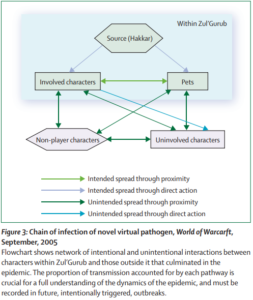Understanding Epidemiology through World of Warcraft
-Kyle Carlos
Introduction
World of Warcraft (WOW)is a legendary MMOORPG (massive multiplayer online role playing game) that at it’s peaked commanded roughly 10 million active players. In this game people would roam the lands of Azeroth, Exploring dungeons, socializing with peers, long distance trading and do raids(massive team). For the purpose of this blog it was essentially a complete digital society, will all the good and bad that comes with it. In 2005, this seemingly harmless game was in research papers and new headlines for one reason alone, “Corrupted Blood”.
The Situation
In 2005 Blizzard (WOW’s developers) released a new update where they added new area meant for high-leveled players. In that raid there was an enemy inflicts a curse “Corrupted Blood” that would slowly decrease the health points of players. This curse was no more than a hindrance for high-leveled players but it would spread quickly to nearby players. Due to a programming error, that curse was not limited to just the new area. This curse, as it was designed for high-leveled players ravaged the much larger lower-level population. There are three aspects to this epidemic. The first was when these high-leveled players left the area and teleported to over highly-populated cities or towns, the curse would spread rapidly. The study by Fefferman estimated the Reproductive rate R > 100. The second being pets. the pets of players are also able to contract the curse, however unlike in real-life in WOW players tend to keep their pets in a stasis, persevering their health and any status aliments they may have. this would result in previous clear cities to suddenly have a new outbreak. Lastly are NPC (non-player characters). These characters are essentially immortal, therefore once they gain the curse they would be a constant source for curse. Since NPC’s are primarily in cities, those cities became ghost towns. The relationship of curse can be seen in the diagram.

Response
These aspects of the WOW epidemic mirror real world examples. the teleportation points in major regions, are similar to airports acting as long range edges to closer connected people. The pets are secondary carriers, similar to animals such as birds or rodents spread curse. Lastly the NPCs are essentially quarantine zones where no one should ever enter. Players attempted many real-world epidemic control strategies that unfortunately ended up failing. Healers would help low-leveled players survive long enough to leave cities. Blizzard also issued quarantines on larger cities and towns. However griefers(players will ill-intent) would reintroduce the curse to the smaller settlements with their pets. The problem was only officially solved when Blizzard did a server-wide reset, cleansing all characters of the curse at once.
While closer to real world diseases, the (SIRS, Susceptible, Infected, Recovered, Susceptible) model is less accurate than the SIS model for this case. Since players weather cured or died, could contract the curse again. the high reproduction rate, with effectively 100% probability to get infected if a player was close enough also meant the epidemic would not die unless everyone was cleansed at once.
Conclusion
What makes the WOW epidemic so interesting for more researching was that it overcall the biggest obstacles of large scale experiments. conducting it on real people would be, too expensive, impossible to manage, unethical and can’t be certain that the participates are taking it seriously. But if this was done through digital simulations, it would be extremely computationally expensive and while also lacking the randomness and irrationality of human behavior. In an environment like WOW where a player’s character is treated like a second life, its possible to overcome all of those obstacles. While there wasn’t the tools in place to properly measure the WOW epidemic by it has opened the door for new directions in epidemiology that could help us avoid future epidemic .
Sources
Lofgren, E. T., & Fefferman, N. H. (2007). The untapped potential of virtual game worlds to shed light on real world epidemics. The Lancet Infectious Diseases, 7(9), 625–629. https://doi.org/10.1016/S1473-3099(07)70212-8